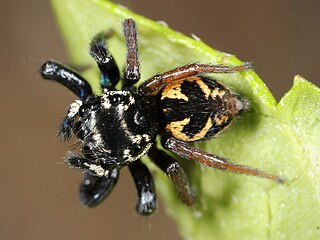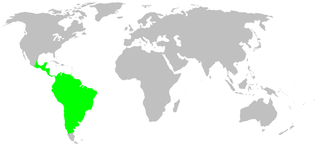
Breda is a genus of jumping spiders that was first described by George Peckham & Elizabeth Peckham in 1894.
Chirothecia is a genus of jumping spiders that was first described by Władysław Taczanowski in 1878. Chirothecia is very similar to Bellota, but can be distinguished by the following characteristics: a much wider and taller cephalothorax ; a much longer eye area ; the posterior median eyes are always closer to the anterior lateral eyes than the posterior lateral eyes.

Corythalia is a genus of jumping spiders that was first described by Carl Ludwig Koch in 1850. The genus is distributed throughout most of the Western Hemisphere. Species of this genus are found in The Americas.

Cotinusa is a genus of jumping spiders that was first described by Eugène Louis Simon in 1900.
Eustiromastix is a genus of jumping spiders that was first described by Eugène Louis Simon in 1902.

Hypaeus is a genus of the spider family Salticidae.

Noegus is a genus of jumping spiders that was first described by Eugène Louis Simon in 1900.

Pachomius is a genus of jumping spiders that was first described by George and Elizabeth Peckham in 1896. Uspachia was merged into genus Romitia in 2007, and all nine species were merged into Pachomius in 2015. The name is derived from Pachomius, the founder of cenobitic monasticism.

Sarinda is a genus of ant mimicking jumping spiders that was first described by George and Elizabeth Peckham in 1892.
Scopocira is a genus of jumping spiders that was first described by Eugène Louis Simon in 1900.

Synemosyna is a genus of ant mimicking jumping spiders that was first described by Nicholas Marcellus Hentz in 1846.

Micrathena, known as spiny orbweavers, is a genus of orb-weaver spiders first described by Carl Jakob Sundevall in 1833. Micrathena contains more than a hundred species, most of them Neotropical woodland-dwelling species. The name is derived from the Greek "micro", meaning "small", and the goddess Athena.

The Dendryphantina are a subtribe of jumping spiders that occur mainly in the New World. The subtribe was first defined by Anton Menge in 1879 as Dendryphantidae. Females of the subtribe generally show paired spots on the abdomen, and the males often have enlarged chelicerae. Females in this subtribe typically have S-shaped epigynal openings.

Senoculus is a genus of araneomorph spiders in the family Senoculidae, and was first described by Władysław Taczanowski in 1872. It is the only genus in the family Senoculidae.

Colonus is a genus of spiders in the jumping spider family, Salticidae. Colonus species are endemic to North and South America, ranging from New York to Argentina. All members of the genus have two pairs of bulbous spines on the ventral side of the first tibiae. The function of these spines is unknown. Colonus was declared a junior synonym of Thiodina by Eugène Simon in 1903, but this was reversed by Bustamante, Maddison, and Ruiz in 2015.

Synema is a genus of spider in the family Thomisidae, found in most parts of the world.

Mangora is a genus of orb-weaver spiders first described by O. Pickard-Cambridge in 1889.

Eustala is a genus of orb-weaver spiders first described by Eugène Simon in 1895.

Ocrepeira is a genus of orb-weaver spiders first described by George Marx in 1883.
Matinta is a genus of South American jumping spiders. The largest number of species are found in Brazil.

















